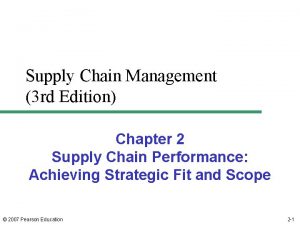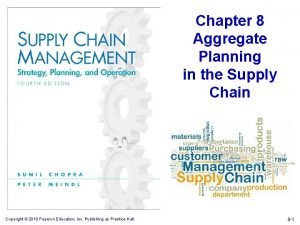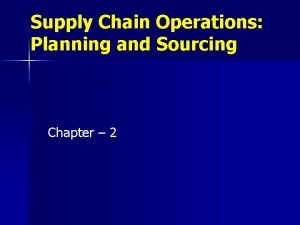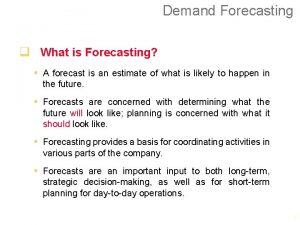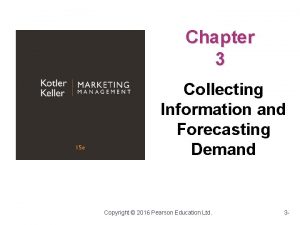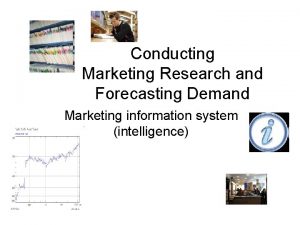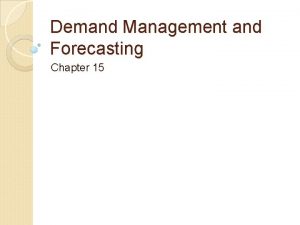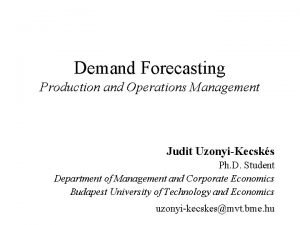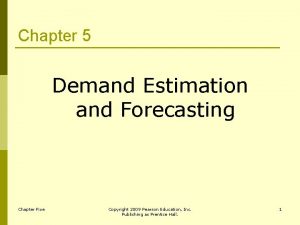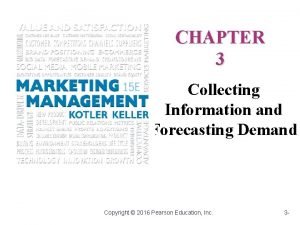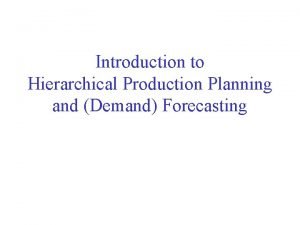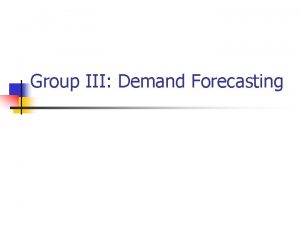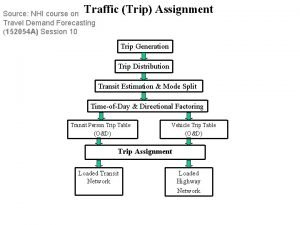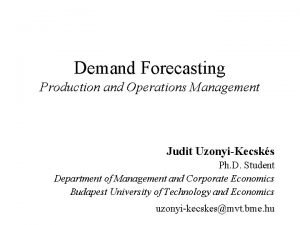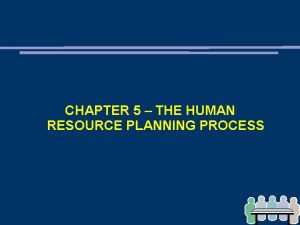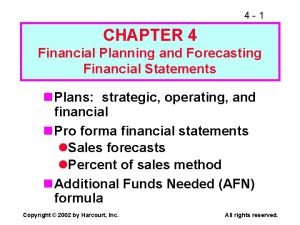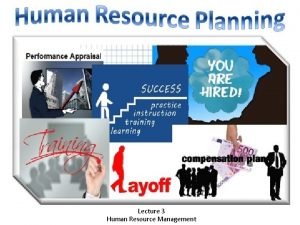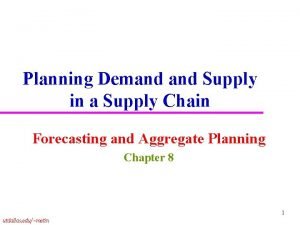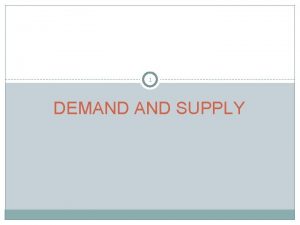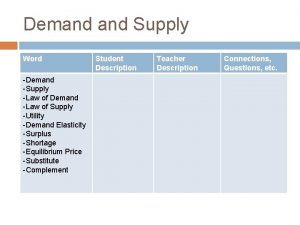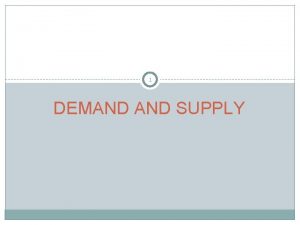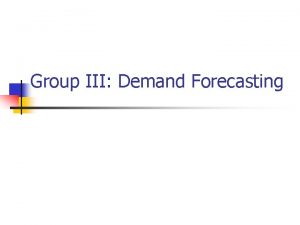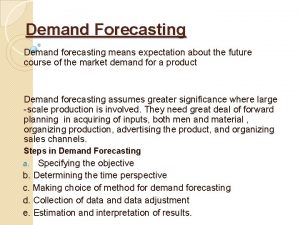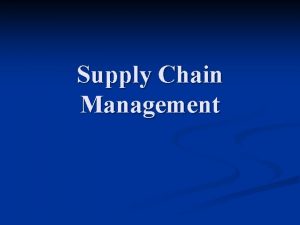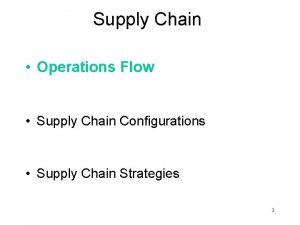Planning Demand Supply in a Supply Chain Forecasting


























































- Slides: 58

Planning Demand Supply in a Supply Chain Forecasting and Aggregate Planning Chapters 8 and 9 1 utdallas. edu/~metin

Learning Objectives u Overview of forecasting u Forecast errors u Aggregate planning in the supply chain u Managing demand u Managing capacity 2 utdallas. edu/~metin

Phases of Supply Chain Decisions u Strategy or design: u Planning: u Operation/Execution Forecast Actual demand u Since actual demands differ from the forecasts, … so does the execution from the plans. – E. g. Supply Chain degree plans for 40 students per year whereas the actual is ? ? 3 utdallas. edu/~metin

Characteristics of forecasts u u Forecasts are always wrong. Include expected value and measure of error. Long-term forecasts are less accurate than short-term forecasts. Too long term forecasts are useless: Forecast horizon – Forecasting to determine » Raw material purchases for the next week; Ericsson » Annual electricity generation capacity in TX for the next 30 years; Texas Utilities » Boat traffic intensity in the upper Mississippi until year 2100; Army Corps of Engineers u Aggregate forecasts are more accurate than disaggregate forecasts – Variance of aggregate is smaller because extremes cancel out » Two samples: {3, 5} and {2, 6}. Averages: 4 and 4. Totals : 8 and 8. » Variance of sample averages/totals=0 » Variance of {3, 5, 2, 6}=5/2 – Several ways to aggregate » Products into product groups; Telecom switch boxes » Demand by location; Texas region » Demand by time; April demand utdallas. edu/~metin 4

Forecasting Methods u Qualitative – Expert opinion » E. g. Why do you listen to Wall Street stock analysts? – What if we all listen to the same analyst? S/He becomes right! u Time Series – Static – Adaptive u u Causal: Linear regression Forecast Simulation for planning purposes 5 utdallas. edu/~metin

Master Production Schedule (MPS) u MPS is a schedule of future deliveries. A combination of forecasts and firm orders. 9 utdallas. edu/~metin

Aggregate Planning Chapter 8 10 utdallas. edu/~metin

Aggregate Planning (Ag-gregate: Past part. of Ad-gregare: Totaled) u u If the actual is different than the plan, why bother sweating over detailed plans Aggregate planning: General plan for our frequency decomposition – Combined products = aggregate product » Short and long sleeve shirts = shirt u Single product » AC and Heating unit pipes = pipes at Lennox Iowa plant – Pooled capacities = aggregated capacity » Dedicated machine and general machine = machine u Single capacity – E. g. SOM has 100 instructors – Time periods = time buckets » Consider all the demand production of a given month together u utdallas. edu/~metin u When does the demand or production take place in a time bucket? Increase the number of time buckets; decrease the bucket length. 11

Fundamental tradeoffs in Aggregate Planning Capacity: Regular time, Over time, Subcontract? Inventory: Backlog / lost sales, combination: Customer patience? Basic Strategies u Chase (the demand) strategy; produce at the instantaneous demand rate – fast food restaurants u Level strategy; produce at the rate of long run average demand – swim wear u Time flexibility; high levels of workforce or capacity – machining shops, army u Deliver late strategy – spare parts for your Jaguar utdallas. edu/~metin 12

- Which is which? Level Deliver late Chase Time flexibility Matching the Demand pa ci ty Adjust the capacity to match the demand Use inventory U se ca Demand Use delivery time utdallas. edu/~metin Demand 13

Capacity Demand Matching Inventory/Capacity tradeoff u Level strategy: Leveling capacity forces inventory to build up in anticipation of seasonal variation in demand u Chase strategy: Carrying low levels of inventory requires capacity to vary with seasonal variation in demand or enough capacity to cover peak demand during season 14 utdallas. edu/~metin

Case Study: Aggregate planning at Red Tomato u Farm tools: u Shovels u Spades Same characteristics? Generic tool, call it Shovel u Forks Aggregate by similar characteristics utdallas. edu/~metin 15

Aggregate Planning at Red Tomato Tools 16 utdallas. edu/~metin

Aggregate Planning What is the cost of production per tool? That is materials plus labor. Overtime production is more expensive than subcontracting. 17 What is the saving achieved by producing a tool in house rather than subcontracting? utdallas. edu/~metin

1. Aggregate Planning (Decision Variables) Wt = Number of employees in month t, t = 1, . . . , 6 Ht = Number of employees hired at the beginning of month t, t = 1, . . . , 6 Lt = Number of employees laid off at the beginning of month t, t = 1, . . . , 6 Pt = Production in units of shovels in month t, t = 1, . . . , 6 It = Inventory at the end of month t, t = 1, . . . , 6 St = Number of units backordered at the end of month t, t = 1, . . . , 6 Ct = Number of units subcontracted for month t, t = 1, . . . , 6 Ot = Number of overtime hours worked in month t, t = 1, . . . , 6 Did we aggregate production capacity? 18 utdallas. edu/~metin

2. Objective Function: 3. Constraints u. Workforce size for each month is based on hiring and layoffs u. Production (in hours) for each month cannot exceed capacity (in hours) 19 utdallas. edu/~metin

3. Constraints u Inventory balance for each month Period t-1 Period t+1 20 utdallas. edu/~metin

3. Constraints u Overtime for each month 21 utdallas. edu/~metin

Execution u Solve the formulation, see Table 8. 3 – Total cost=$422. 275 K, total revenue=$640 K u Apply the first month of the plan Delay applying the remaining part of the plan until the next month Rerun the model with new data next month u This is called rolling horizon execution u u 22 utdallas. edu/~metin

Aggregate Planning at Red Tomato Tools This solution was for the following demand numbers: What if demand fluctuates more? utdallas. edu/~metin 23

Increased Demand Fluctuation Total costs=$432. 858 K. 16000 units of total production as before why extra cost? utdallas. edu/~metin With respect to $422. 275 K of before. 24

Manipulating the Demand Chapter 9 25 utdallas. edu/~metin

Matching Demand Supply u Supply = Demand u Supply < Demand => Lost revenue opportunity u Supply > Demand => Inventory u Manage Supply – Productions Management u Manage Demand – Marketing 26 utdallas. edu/~metin

Managing Predictable Variability with Supply Manage capacity » » Time flexibility from workforce (OT and otherwise) Seasonal workforce, agriculture workers Subcontracting Counter cyclical products: complementary products u Similar products with negatively correlated demands – Snow blowers and Lawn Mowers – AC pumps and Heater pumps » Flexible capacities/processes: Dedicated vs. flexible a d a b c Similar capabilities utdallas. edu/~metin b d a, b, c, d c One super facility 27

Managing Predictable Variability with Inventory u Component commonality – Remember fast food restaurant menus – Component commonality increase the benefit of postponement. » More on this later u Build seasonal inventory of predictable products in preseason – Nothing can be learnt by procrastinating u Keep inventory of predictable products in the downstream supply chain 28 utdallas. edu/~metin

Managing Predictable Variability with Pricing Revisit Red Tomato Tools u Manage demand with pricing – Original pricing: » Cost = $422, 275, Revenue = $640, 000, Profit=$217, 725 u Demand increases from discounting – Market growth – Stealing market share from competitors – Forward buying » stealing your own market share from the future Discount of $1 in a period increases that period’s demand by 10% (market and market share growth) and moves 20% of next two months demand forward Can you gather this information –price sensitivity of the demand- easily? Does your company have this information? 29 utdallas. edu/~metin

Off-Peak (January) Discount from $40 to $39 Cost = $421, 915, Revenue = $643, 400, Profit = $221, 485 30 utdallas. edu/~metin

Peak (April) Discount from $40 to $39 Cost = $438, 857, Revenue = $650, 140, Profit = $211, 283 Discounting during peak increases the revenue 31 but decreases the profit! utdallas. edu/~metin

Demand Management u Pricing and Aggregate Planning must be done jointly u Factors affecting discount timing and their new values – Consumption: 100% increase in consumption instead of 10% increase – Forward buy, still 20% of the next two months – Product Margin: Impact of higher margin. What if discount from $31 to $30 instead of from $40 to $39. ) 32 utdallas. edu/~metin

January Discount: 100% increase in consumption, sale price = $40 ($39) Off peak discount: Cost = $456, 750, Revenue = $699, 560 Profit=$242, 810 33 utdallas. edu/~metin

Peak (April) Discount: 100% increase in consumption, sale price = $40 ($39) Peak discount: Cost = $536, 200, Revenue = $783, 520 Profit=$247, 320 34 utdallas. edu/~metin

Performance Under Different Scenarios Use rows in bold to explain Xmas discounts. The product, with less (forward buying/market growth) ratio, is discounted more. What gift should you buy on the special days (peak demand) when retailers supposedly give discounts? E. g. Think of flowers on valentine’s day. How about diamonds? For flowers, what is (forward buying/market growth) due to discounting? How about for diamonds? Need empirical data. What is available? utdallas. edu/~metin 35

Empirical Data: Who spends / How much on Valentine’s day u u The average consumer spends $122. 98 on 2008 Valentine’s Day, similar to $119. 67 of 2007. Total US spending on Valentine’s Day is $17. 02 B by 18+. Spending – by gender » Men again dishes out the most in 2008, spending an average of $163. 37 on gifts and cards, compared to an average of $84. 72 spent by women. – by age u Adults: 25 -34 spend $160. 37. Young adults: 18 -24 spend $145. 59. Upper Middle age: 45 -54 spend $117. 91. Lower Middle age: 35 -44 spend $116. 35. Elderly: 55 -64 spend $110. 97. » » » » 56. 8% of all consumers give a greeting card. 48. 2% plan a special night out. 48. 0% buy candy. 35. 9% buy flowers. 12. 3% give a gift card. e h 11. 8% buy clothing. W ? ? . ? % buy diamonds h t w » » » e k r a m r ing? o y unt u b co d r is a w to d r fo ue s i d e r Gifts utdallas. edu/~metin ro g t – Source: National Retail Federation www. nrf. com 36

Factors Affecting Promotion Timing 37 utdallas. edu/~metin

Aside: Continuous Compounding u u u If my $1 investment earns an interest of r per year, what is my interest+investment at the end of the year? Answer: (1+r) If I earn an interest of r/2 per six months, what is my interest+ investment at the end of the year? Answer: (1+r/2)2 If I earn an interest of (r/m) per (12/m) months, what is my interest+investment? Answer: (1+r/m)m Think of continuous compounding as the special case of discrete-time compounding when m approaches infinity. What if I earn an interest of (r/infinity) per (12/infinity) months? 38 utdallas. edu/~metin See the appendix of scaggregate. pdf for more on continuous compounding.

Deterministic Capacity Expansion Issues u Single vs. Multiple Facilities – Dallas and Atlanta plants of Lockheed Martin u Single vs. Multiple Resources – Machines and workforce; or aggregated capacity u Single vs. Multiple Product Demands – Have you aggregated your demand when studying the capacity? u Expansion only or with Contraction – Is there a second-hand machine market? u Discrete vs. Continuous Expansion Times – Can you expand SOM building capacity during the spring term? u Discrete vs. Continuous Capacity Increments – Can you buy capacity in units of 2. 313832? u u Resource costs, economies of scale Penalty for demand-capacity mismatch – Recallable capacity: Electricity block outs vs Electricity buy outs » Happens in Wisconsin Electricity market » What if American Airlines recalls my ticket u Single vs. Multiple decision makers utdallas. edu/~metin 39

A Simple Model No stock outs. x is the size of the capacity increments. δ is the increase rate of the demand. 40 utdallas. edu/~metin

Infinite Horizon Total Discounted Cost u f(x) is expansion cost of capacity increment of size x C(x) is the long run (infinite horizon) total discounted expansion cost u 41 utdallas. edu/~metin

Solution of the Simple Model Solution can be: Each time expand capacity by an amount that is equal to 30 -week demand. utdallas. edu/~metin 42

Shortages, Inventory Holding, Subcontracting u Use of Inventory and subcontracting to delay capacity expansions 43 utdallas. edu/~metin

Stochastic Capacity Planning: The case of flexible capacity 1 A y 1 A=1, y 2 A=1, y 3 A=0 B y 1 B=0, y 2 B=0, y 3 B=1 2 3 Plants u u u Products Plant 1 and 2 are tooled to produce product A Plant 3 is tooled to produce product B A and B are substitute products – with random demands DA + DB = Constant utdallas. edu/~metin 44

Capacity allocation u Say capacities are r 1=r 2= r 3=100 u Suppose that DA + DB = 300 and DA >100 and DB >100 With plant flexibility y 1 A=1, y 2 A=1, y 3 A=0, y 1 B=0, y 2 B=0, y 3 B=1. Scenario DA DB X 1 A X 2 A X 3 A X 1 B X 2 B X 3 B 1 200 100 100 0 2 150 100 50 B 3 100 200 100 100 B If the scenarios are equally likely, expected shortage is 50. utdallas. edu/~metin Shortage 45

Capacity allocation with more flexibility u Say capacities are r 1=r 2= r 3=100 u Suppose that DA + DB = 300 and DA >100 and DB >100 With plant flexibility y 1 A=1, y 2 A=1, y 3 A=0, y 1 B=0, y 2 B=1, y 3 B=1. Scenario DA DB X 1 A X 2 A X 3 A X 1 B X 2 B X 3 B Shortage 1 200 100 100 0 2 150 100 50 50 100 0 3 100 200 100 100 0 Flexibility can decrease shortages. In this case, from 50 to 0. 46 utdallas. edu/~metin

A Formulation with Known Demands: Dj=dj u u u u i denotes plants j denotes products, not necessarily substitutes cij tooling cost to configure plant i to produce j mj contribution to margin of producing/selling a unit of j ri capacity at plant i Dj=dj product j demand yij=1 if plant i can produce product j, 0 o. w. xij=units of j produced at plant i utdallas. edu/~metin Solutions depend on scenarios: - If DA=200 and DB=100, then y 1 A=y 2 A=y 3 B=1. - If DA=100 and DB=200, then y 1 A=y 2 B=y 3 B=1. 47

Unknown Demands: Dj=djk with probability pk u Dj=djk product j demand under scenario k u xijk= units of j produced at plant i if scenario k happens u yij=1 if plant i can produce product j, 0 o. w. u Does yij differ under different scenarios? Should my variable depend on scenarios? (Yes / No) Anticipatory variable and Nonanticapatory variable 48 utdallas. edu/~metin

Reality Check: How do car manufacturers assign products to plants? u u With the last formulation, we treated the problem of assigning products to plants. This type of assignment called for tooling/preparation of each plant appropriately so that it can produce the car type it is assigned to. These tooling (nonanticipatory) decisions are made at most once a year and manufacturers work with the current assignments to meet the demand. When market conditions change, the product-to-plant assignment is revisited. – Almost all car manufacturers in North America are retooling their previously truck manufacturing plants to manufacture compact cars as consumer demand basically disappeared for trucks with high gas prices. – Also note that the profit margin made from a truck sale is 2 -5 times more than the margin made from a car sale. No wonder why manufacturers prefer to sell trucks! u In the following pages, you will find the product to plant assignment of major car manufacturers in the North America. These assignments were updated in the summer of 2008 just about the time when manufacturers started talking 49 about retooling plants to produce compact cars. utdallas. edu/~metin

All of Toyota Plants in the North America Toyota. Cambridge Corolla, Matrix, Lexus, Rav 4 Toyota-Subaru. La. Fayette Camry Nummi: Toyota-GM. Freemont. Corolla, Tacoma, Pontiac Vibe Toyota. Princeton Tundra, Suquoia, Sienna Toyota. Georgetown Avalon, Camry, Solara Toyota. Long Beach Hino Toyota. Blue Springs Highlander Toyota. Tijuana, Mexico Tacoma Toyota. San Antonio Tundra 50 utdallas. edu/~metin

All of Honda Plants in the North America Honda. Alliston, Ca. Civic, Acura, Odyssey, Pilot, Ridgeline Honda. Decatur TBO in 2008 Honda. Marysville Accord, Acura Honda. Lincoln Odyssey, Pilot Honda. El Salto, Me Accord 51 utdallas. edu/~metin

All of Nissan Plants in the North America Nissan. Smyrna Frontier, Xterra, Altima, Maxima, Pathfinder Nissan. Canton Quest, Armada, Titan, Infiniti, Altima 52 utdallas. edu/~metin

All of Hyundai-Kia Plants in the North America Kia. La. Grange TBO in 2009 Hyundai. Montgomery Sonata, Santa Fe 53 utdallas. edu/~metin

All of Mercedes and BMW Plants in the North America BMW. Spartanburg Z 4, X 5, X 6 M roadster, coupes Mercedes. Tuscaloosa M, R classes 54 utdallas. edu/~metin

All of Ford Plants in the North America Ford. Dearborn F-150, Lincoln Mark LT Ford. Flat Rock Mustang, Mazda 6 Ford. Oakville, Ca. Edge, Lincoln MKX Ford. Saint Paul Ranger, Mazda B series Ford. Saint Thomas, Ca. Crown Victoria, Grand Marquis Ford. Wayne Focus, Expedition, Lincoln Navigator Ford. Chicago Taurus, Mercury Sable Ford. Avon Lake E Series Ford. Kansas City Escape, Escape Hybrid, Mazda Tribute, Mercury Mariner, F-150 Ford. Louisville F-250, F-550, Explorer, Mercury Mountaineer Ontario, Michigan, Illinois, Indiana, Ohio in Focus Ford. Hermosillo, Mex. Ford Fusion, Lincoln MKZ, Mercury Milan 55 utdallas. edu/~metin Ford. Cuatitlan, Mex. F-150, 250, 350, 450, 550, Ikon

All of Chrysler Plants in the North America Chrysler. Sterling Heights Dodge Avenger, Chrysler Sebring Chrysler. Brampton, Ca Chrysler 300, Dodge Challenger, Dodge Charger Chrysler. Warren Dodge Ram, Dakota, Mitsubishi Raider Chrysler. Detroit-Jefferson North Jeep Grand Cherokee and Commander Chrysler. Detroit-Conner Ave. Dodge Viper, SRT 10 Roadster Chrysler. Windsor, Ca Dodge Grand Caravan, Chrysler Town Chrysler. Belvidere Dodge Caliber, Jeep Compass, Jeep Patriot Chrysler. Toledo Jeep Liberty, Dodge Nitro Chrysler. Newark Dodge Durango, Chrysler Aspen Will close in 2009 Chrysler. Fenton-North Dodge Ram Chrysler. Fenton-South Grand Voyager, Grand Caravan, Cargo Van Ontario, Michigan, Illinois, Indiana, Ohio in Focus Chrysler. Saltillo, Mex. Dodge Ram 56 utdallas. edu/~metin Chrysler. Toluca, Mex. Chrysler PT Cruise, Dodge Journey

All of GM Plants in the North America GM. Lansing-Grand River Cadillac E-SRX GM. Lansing-Delta Township Buick Enclave, Saturn Outlook, GMC Acadia GM. Orion Pontiac G 6, Chevrolet Malibu GM. Oshawa, Ca Chevy Impala, Buick Allure, Chevy Silverado, GMC Sierra. Trucks will stop in 2009. GM. Flint GMC Sierra, Chevy Silverado, Chevy - GMC medium trucks. GM. Pontiac Chevy Silverado, GMC Sierra GM. Detroit Buick Lucerne, Cadillac DTS GM. Janisville Chevy Tahoe, Suburban, GMC Yukon Will stop in 2010 GM. Wilmington Saturn L series, Pontiac Solstice GM. Fort Wayne Chevy Silverado, GMC Sierra GM. Moraine Chevy Trailblazer, GMC Envoy, Oldsmobile Bravada, Isuzu Ascender, Saab 9 -7 X Will stop in 2010 GM. Fairfax Chevy Malibu, Malibu Maxx, Saturn Aura GM. Lordstown Chevy Cobalt, Pontiac Pursuit, G 4, G 5 GM. Wentzville Chevy Express, GMC Savana GM. Bowling Green Cadillac XLR, Chevy Corvette GM. Spring Hill Saturn Ion and Vue Currently down GM. Doraville Chevy Uplander, Pontiac Montana Ontario, Michigan, Illinois, Indiana, Ohio in Focus GM. Arlington Chevy Tahoe, Suburban, GMC Yukon, Cadillac Escalade GM. Shreveport Chevy Colorado, GMC Canyon, Isuzu brands, Hummer H 3 GM. Ramos Arizpe, Mex. Pontiac Aztek, Chevy Cavalier, Chevrolet Checy, Pontiac Sunfire, Buick Rendezvous GM. Silao, Mex. Chevrolet Suburban, Chevrolet Avalanche, GMC Yukon, Cadillac Escalade utdallas. edu/~metin GM. Toluca, Mex. Chevrolet Kodiak Truck Stopping in 2008 57

Summary of Learning Objectives u Forecasting u Aggregate planning u Supply and demand management during aggregate planning with predictable demand variation – Supply management levers – Demand management levers u Capacity Planning 58 utdallas. edu/~metin

Material Requirements Planning u Master Production Schedule (MPS) u Bill of Materials (BOM) u MRP explosion u Advantages – Disciplined database – Component commonality u Shortcomings – Rigid lead times – No capacity consideration 59 utdallas. edu/~metin

Optimized Production Technology u Focus on bottleneck resources to simplify planning u Product mix defines the bottleneck(s) ? u Provide plenty of non-bottleneck resources. u Shifting bottlenecks 60 utdallas. edu/~metin

Just in Time production u u u u Focus on timing Advocates pull system, use Kanban Design improvements encouraged Lower inventories / set up time / cycle time Quality improvements Supplier relations, fewer closer suppliers, Toyota city JIT philosophically different than OPT or MRP, it is not only a planning tool but a continuous improvement scheme 61 utdallas. edu/~metin
 Matching supply and demand in supply chain
Matching supply and demand in supply chain Demand forecasting managerial economics
Demand forecasting managerial economics Who are they
Who are they Chain ratio method of demand forecasting
Chain ratio method of demand forecasting Collaborative planning forecasting
Collaborative planning forecasting Supply forecasting in hrm
Supply forecasting in hrm Module 5 supply and demand introduction and demand
Module 5 supply and demand introduction and demand Implied demand uncertainty in supply chain management
Implied demand uncertainty in supply chain management Eltonian pyramid
Eltonian pyramid Value chain and supply chain difference
Value chain and supply chain difference Advanced supply chain planning
Advanced supply chain planning Aggregate planning in supply chain management
Aggregate planning in supply chain management Logistics vision statement examples
Logistics vision statement examples Supply chain operations planning
Supply chain operations planning Objectives of outsourcing
Objectives of outsourcing Hotel demand forecasting
Hotel demand forecasting Statistical methods of demand forecasting
Statistical methods of demand forecasting Importance of demand forecasting
Importance of demand forecasting Statistical methods of demand forecasting
Statistical methods of demand forecasting Demand estimation and forecasting
Demand estimation and forecasting Barometric methods are used to forecast
Barometric methods are used to forecast Forecasting and demand measurement in marketing
Forecasting and demand measurement in marketing Forecasting and demand measurement in marketing
Forecasting and demand measurement in marketing Collecting information and forecasting demand summary
Collecting information and forecasting demand summary Forecasting demand for autonomous vehicles
Forecasting demand for autonomous vehicles Demand measurement in marketing
Demand measurement in marketing Demand forecasting objectives
Demand forecasting objectives Micro level demand forecasting
Micro level demand forecasting Demand forecasting in operations management
Demand forecasting in operations management Forecasting and demand measurement in marketing
Forecasting and demand measurement in marketing Demand estimation and forecasting
Demand estimation and forecasting Collecting information and forecasting demand
Collecting information and forecasting demand Dynamic traffic assignment
Dynamic traffic assignment Demand forecasting introduction
Demand forecasting introduction Demand forecasting objectives
Demand forecasting objectives Limitations of demand forecasting
Limitations of demand forecasting Simultaneous equation method in demand forecasting
Simultaneous equation method in demand forecasting Marketing approach to demand measurement
Marketing approach to demand measurement Marketing research and forecasting demand
Marketing research and forecasting demand Conducting marketing research and forecasting demand
Conducting marketing research and forecasting demand Source nhi
Source nhi Demand forecasting introduction
Demand forecasting introduction Tracking signal
Tracking signal Gathering information and measuring market demand
Gathering information and measuring market demand Air travel demand forecasting
Air travel demand forecasting Why is forecasting important in human resource planning
Why is forecasting important in human resource planning Forecasting techniques in human resource planning
Forecasting techniques in human resource planning Collaborative planning forecasting and replenishment ppt
Collaborative planning forecasting and replenishment ppt Financial planning and forecasting
Financial planning and forecasting Financial planning and forecasting
Financial planning and forecasting Strategi peramalan
Strategi peramalan Planning budgeting forecasting
Planning budgeting forecasting Short term financial planning
Short term financial planning Financial planning and forecasting problems with solutions
Financial planning and forecasting problems with solutions Financial analysis planning and forecasting
Financial analysis planning and forecasting Short-term financial management
Short-term financial management Forecasting the supply of outside candidates
Forecasting the supply of outside candidates Hr supply forecasting techniques
Hr supply forecasting techniques Forecasting the supply of inside candidates
Forecasting the supply of inside candidates







